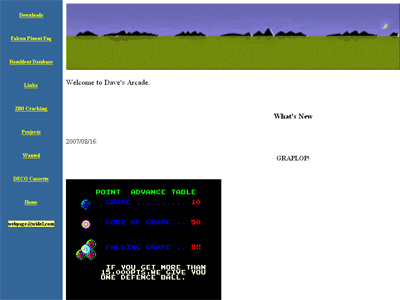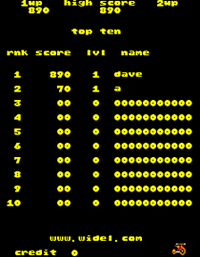Jr. Pac-man High Score Saver
After today, my list of techs that have the prowess to make modification kits and high score save boards for classic arcade games read Jrok, Matt Osborn, Mark Spaeth, Mike Doyle, Clay Cowgill, Jeff Kulczycki and Dave Widel. A week ago, I hadn’t done a lot of research into others who were making custom boards and kits but then I came across Matt Osborn’s kit’s mostly for Konami games, and he turned me onto Dave Widel.

Here is a screenshot of his website. It’s pretty basic, but has some great arcade information. Dave Widel made a high score save kit / board for Bally’s Jr. Pac-man, that also works on the regular Pac-man and Ms. Pac-man boards. Visit this page to read more details on the score save modifications. As you can see from the photo below, it is a simple as plugging this board into your Jr. Pac-man PCB at the correct location.

The screen shots of the save screens look very similar to Mike Doyle’s 96 in 1 Multi Pac kit. I haven’t been around long enough in the arcade collecting realm to know who came first, but my guess would be that Mike Doyle used Dave Widel’s modifications.


I really want one of these Jr. Pac-man save boards, but I read on his website that I might be out of luck;
Unfortunately the nvram I was using was discontinued and the ones I can get have quadrupled in price making this much less cost effective.
I emailed Dave and he did get back with me at least. He is going to check and see if he has any Jr. Pac-man high score save kits left. He said it would be around $50, which is right in line with other kit prices.
The only other question I have, how will this kit (which also switches between fast and slow Jr. Pac-man gameplay) work with the custom kit Mark Spaeth made? Just like the 96 in 1 Multi Pac (but in this case it’s the speed), you make adjustments by with joystick and button control combos;
The only thing you need to know to use it is holding both buttons and pushing up or down will change the speed of pacman.
Mark’s kit swapped out 8D, and this swaps out the z80 processor, so I wouldn’t think there would be an issue. Does anyone else know enough to know whether the two kits would conflict? Who else am I listed from the list of guys above who makes kits and custom arcade game mod boards?
Here are some similar arcade posts
- Multi Q-Bert Kit T-Shirt
- Purchased a 96 in 1 Multi Pac Kit
- New Multi Q*Bert Shirts are @!#?-ing Awesome!
- Installing the 96 in 1 Multi Pac – Part 2
- High Score Save for Konami Gyruss
If you enjoyed this post, please consider to leave a comment or subscribe to the feed and get future articles delivered to your feed reader.
Comments
I didn’t read through all of the projects, but I would be interested to know more about the Playchoice adapter to play NES carts. How awesome would that be! I would have to buy a Playchoice for sure then.
Plus he mentions the Q*Bert multigame;
Mike Doyle did a production run of these… We may consider another run at some point.
So maybe Dave and Mike Doyle work closely side by side? That would explain the similarities in the Pac-man kits.
The NES cart should be easy (you know for a nuclear physicist) for these guys. It was a goofy hardware dongle trick to “protect” Nintendo’s market. All the noise about DRM now indicates it was just invented, but it’s old tech.
As I understand it the “commercial” carts check for a chip on the Playchoice board much like Mac OSX. Except for the extra circuit, the Playchoice IS two famicom boards, one for the game and one for the menu/instruction screen.
Dave Widel emailed me back on the Q*bert kits, he made them and had Mike Doyle sell them…
As for the idea of using Nintendo cartridges with a full size Playchoice, here is a link that I found off of Wikipedia for a guy out of German that claims that he has a solution to make carts possible on a PC10. (I didn’t include a screenshot, the site is chartreuse green, it hurts my eyes and brain to look at it) His solution is some sort of BIOS rewrite and would require someone to have a eeprom burner, as well as a personality to throw caution to the wind I suppose.
Like you said Jim, something simple that helped protect the popularity of home console systems…
What are famicom boards? Is that a brand of circuit board makers?
Sorry, I used jargon. The name famicom refers to the NES system. The same hardware was sold in Japan as the Family Computer or FamiCom. I never lived in Japan in those days, so I am not sure if that name is a “codename” for the project or the actual name used to market the product.
The boards were made by Nintendo.
Now that you told me the story about the Family Computer – FamiCom, I had heard of that and knew the story behind the Famicom system / Nintendo Entertainment System.
In the Discovery special from earlier last year, “I, Video”, one of the narrators talks about the name change. Here is the transcription on how the console name was changed;
The Nintendo Entertainment System was originally called Famicom – for the family. When the marketers came to bring it to the US they realized they couldn’t call it the Famicon because families don’t play together. They changed the name to the Nintendo Entertainment System to introduce it to America because they realized that the word family had negative connotations when associated with entertainment in this country.
So, Nintendo became popular in America, but the boards were still named after the console system in Japan, and those were the boards used to make Playchoice Uprights later on.
Leave a comment
Your email address is never displayed and cannot be spammed. If your comments are excessively self-promotional you will be banned from commenting. Read our comment privacy policy.



February 20, 2008
I am a big fan of Matt Osborn’s work. I will have to check out Widel’s work.